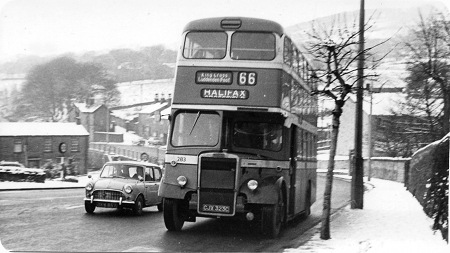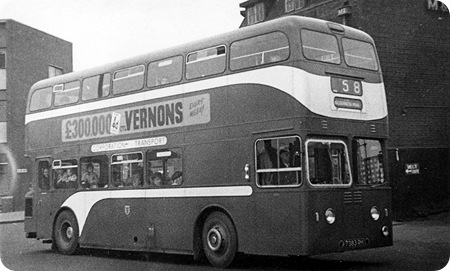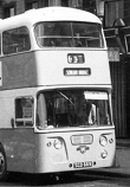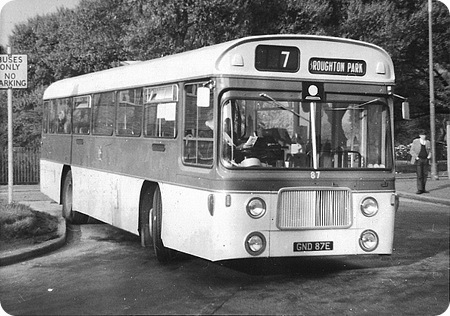
Manchester City Transport
1967
Leyland Panther PSUR1/1
MCW B40D
It may seem barely credible now, but in the early 1960s Manchester Corporation was planning a future without double-deckers. They had realised (possibly before anyone else) that the days of the bus conductor were numbered, but at that time only a single-decker could be operated legally without one. As a preliminary step towards total conversion to single deck one-man operation (as it then was), the Corporation carried out strategic experiments in new methods of fare collection, initially using 20 Park Royal-bodied Panther Cubs, a model created by Leyland at Manchester’s request. These were to have been followed by 30 full-grown Panthers with MCW bodies, but in the event only 29 of these were delivered. The missing Panther had been destroyed by fire at the body builders and was not replaced, because by then it was 1967 and the world had changed significantly. Conductorless operation of double-deckers was now imminent, and the plan for an all single-deck fleet was consigned to oblivion.
Although the Panthers rapidly faded from prominence, and were never very well known to enthusiasts, I was personally very fond of them. They were among the first Manchester buses to revert to red interiors after a dozen years of drab and incongruous green, and for me they produced some of the most pure and thrilling Leyland sound effects of all time.
In this April 1968 photo, Panther no. 87 (GND 87E) waits at the Brookdale Park (Newton Heath) terminus of route 7, a rather rambling inter-suburban service on the north side of the city, which in earlier years had taken me to school by Leyland PD2.
Photograph and copy contributed by Peter Williamson
Thanks for showing the photo above, it is becoming more impossible as time goes by to get bus photos, in service of Manchester corporation transport, mainly in the 1950/1960s periods, ie such buses as Crossley, Leyland Titan TD5s etc. Also for many years I have failed in obtaining copies, or even photocopies of Manchester fleet list/allocation lists for years 1946 to 1959, 1952 to 1953 and 1961, makes me wonder if I will ever get them as I am getting on in years now.
Can anyone help please.
Michael Cregeen
Answer for Michael Cregeen, regarding Manchester Corporation fleet list.
Try this link and scroll down to item 88, which lists the Manchester tram, trolleybus and bus fleets, the latter divided into (1) 1906-35, (2) 1936-50, (3) 1951-69. Sorry, can’t help with the photographs. Finally, I don’t want to be personal, but Cregeen sounds like a Manx name. I remember a school holiday to the IOM in 1960, and we were transported around the island on a pair of Bedford coaches from Cregeens of Port Erin (an OB and an SB I think).
Any relation?
Stephen Ford
My thanks to Stephen for his very helpful answer but the type of Manchester fleet lists I am trying to get, or photocopies will do show the bus fleet and depot allocations rather than just fleet. These where published by Manchester Corporation Transport themselves. The years I cannot get are 1946 to 1950, 1952 to 1953 and 1961. Also selnec similar lists from 1971 to 1975.
Thanks in hope.
Michael Cregeen.
Michael, if you don’t mind black and white, Jaspers has 115 images with prints for sale, buses ranging from 2029 to 4644, at this link.
Peter Williamson
Something has confused me for many years. When 4490, 4500, 4509 were transferred from Birchfields Road to Northenden, this was odd in itself, but as far as I am aware they where never used by Northenden on all day service, they were used only on part day and works duty. This despite the rest at Birchfields being out all day. Also similar when 4550-4559 went from Birchfields to Northenden, they where used on part day also, and yet the rest of the batch including a few which went to Princes Road where out all day on the Flixton services. Never got to the bottom of this does anyone know anything?
Also after over 30 years of trying I still cannot get my hands on MCTD fleetlist/allocation lists for the years 1946-1950, 1953 and 1961, even photocopies would do. As regarding selnec/gmt ones from 1971 onwards I give up can anyone help please?
I have not got a computer, I use a library internet connection so not always available.
Michael Cregeen
Michael, I am interested in your question about the transferred Daimlers, but you do not say when the transfers took place. If it was well into the Fleetline era, then it may have been for capacity reasons. A few other facts that may be relevant:
1. Only about one-third of the Manchester fleet, mainly the newest third, was used on all-day duties, and the exact proportion would be different at different depots.
2. The five-cylinder Daimlers, which included 4490-4509, couldn’t keep up with the traffic on Princess Road/Parkway, which was Northenden’s main radial thoroughfare.
3. Industrial relations were handled separately at each depot, and Northenden was known as the most militant.
Peter Williamson
I have received an email from The Museum of Transport Greater Manchester giving contact details and inviting Michael to get in touch with their Archives department and they feel sure they can help him with his search for MCTD fleet lists. Hopefully Michael will let us know how he goes on.
Peter
Still cannot obtain the Manchester Corporation fleet/allocation lists for years 1946-1950,1952,1953,1961, nobody at The Museum of Transport Greater Manchester ever replies to my correspondence, but living in hope someone can send these, or photocopies one day.
Michael Cregeen 09/10
Please read Michaels comment above first
I do wish people would not promise to do something that they have no intention of doing. I know that the people behind the scenes at the museum are volunteers but the Director who wrote to me 04/03/2010 – 23:27 (name withheld) promised that it would be no problem, six months is a long time to wait for an acknowledgement to a request for information and I do not think for one moment that it is the only request they have had from Michael.
Peter
Monday September 5th 1966 when Sunderland Corporation Transport bought 33 Leyland Panther Buses accepting tokens for 2d-9d every 10 journeys.
The Bus Driver for selling bus tokens on FBR 53D is the late Norman Burlison from day one.
Types of buses including Daimler Roadliners, AEC Swifts, Bristol RE’s and Daimler Fleetlines from the sixties.
I will never forget the Leyland Panther Buses from the Sunderland Corporation Transport.
Terry Christie
In 1971 3 ex Selnec Panthers came to Ireland, one of those being GND 87E a few years later they were sold back to Cranes & Commercials in Southampton and then exported to Australia.
Sean
I just came across these articles whilst looking round the net. I remember the Daimler vehicles in use. I started at Queens Road depot in 64 as a guard then becoming a driver in 69. The comments about the Daimlers lack of pace was certainly true. If we were working the 53, (the banana route). It be good to have a Princess Road vehicle in front, every 3 Min’s on the timetable. We would have caught up with their Daimler by the time we got to Bradford Cemetery. We occasionally had Daimlers with a pre-selector gearbox at Queens Road. They had the habit of the selector pedal jumping out. It took a lot of effort to get it back in again. One driver, who was an ex jockey, was unable to get moving again, no matter how his 8 stone tried. Withy Grove at the junction of High Street was gridlocked till another driver came to his aid. We also had some modern, then, Daimlers with crash gears, they had nice comfortable interiors; but slow. We used them on the 4 service, this was the nearest thing we had to a rural bus service, Cannon St. to Bamford via Heaton Park and Heywood. They were suited to the steadier pace required. I never drove one, they had gone before I became a driver but those old pre-selectors, it took some thinking about to plan which gear you wanted next.
The pictures of the single deckers on the 7 service also stirs memories. They tried a system on the no. 7 and 123 services; Minimax. The fare was 6d for any distance, 3d half. The passenger had to put his sixpence in to operate a turnstile to travel; the left hand turnstile allowed the driver to let children or passes to use their threepence to get on. People didn’t have the correct coins, it was bound to fail, that and the centre exit.
Peter Furnival
04/05/2012 07:34
I found this site quite by accident and really find it very interesting. I previously wrote that I was a conductor and driver at Birchfields road from 1959 to 1978, and that I found the Leyland 3400’s a pleasure to drive. Does anyone know what happened to 3427? If it possibly made preservation, or went the same final route of so many more golden oldies. She had a real ‘throaty’ rumble from her exhaust, and made the hair on the back of my neck tingle and I always drove with the small window in the driver’s door open!
Bill Parkinson
05/09/12 – 06:57
I remember being quite excited by these Manchester Panthers when new, they looked so modern at the time in their cream and red livery. The turnstile arrangement inside them was less popular though. Among other things it had an unfortunate habit of catching and lifting the then fashionable miniskirts, to the serious embarrassment of the wearer. I particularly remember them on the 123, and on the 67X which ran (I think Saturdays Only) from Belle Vue to Clayton Bridge or Newton Heath. They also sometimes popped up on the 73, Ryder Brow Circular, traditionally a route that threw up interesting buses.
Brian Wainwright
15/10/12 – 07:51
Re the interiors of the Panthers, the first vehicles to revert to red interiors were the 1965 batch of Atlanteans. The following batches of Atlanteans and Fleetlines had red and black interiors.
The green and beige scheme adopted from 1953 was based on the RT scheme of London Transport. When the cost and weight of the wood and paint interiors on the post war Standards had to be replaced on what were bodybuilders’ designs, rather than specific Manchester designs, Albert Neal decided that he could both save cost and offer his passengers a brighter interior.
Phil Blinkhorn
15/10/12 – 10:55
The Panthers also turned up on the 201 service from Woodhouse Lane to Sale Moor soon after the introduction of the route, replacing Panther Cubs. This service was technically "joint" with North Western (due to the area agreement which made everywhere to the west of the A56 in Sale the territory of NWRCC), but as far as I know the single vehicle required was always supplied by MCTD.
Neville Mercer
16/10/12 – 05:25
It is recorded in "The Manchester Bus" (Eyre and Heaps) that the whole of the 1965 batch of Atlanteans (3721-3792) had red interiors, but it was not so. The early ones had grey interiors with the usual green seats downstairs and tan upstairs. This scheme can be seen on the preserved Panther Cub. Round about 3760 there were a couple of experimental schemes (including some nasty black and yellow moquette as I recall) and the red started after that.
Peter Williamson
16/10/12 – 11:48
As I recall, MCTD had very few single deckers during the 50’s and 60’s….The only ones I can remember seeing in the southern parts of the city were those which operated the 22 route from Levenshulme, opposite the McVities biscuit factory, to (was it?) Eccles, a fairly long route of maybe 10 to 15 miles but with a low bridge just a couple of hundred yards from the Levenshulme terminus, hence the single deckers….In hindsight, it now seems a bit odd to have had a separate fleet for the sake of a few hundred yards of road, so maybe they were used elsewhere on the network although I don’t remember seeing them anywhere else….I can’t remember exactly what make/type these were, I think that they were Leylands, but I have in my memory that they were fairly odd looking with a rear entrance….Or maybe after so many years I’m confusing them with the rear entrance Albions (or was it, even, Atkinsons ?) that NWRCC used to operate – and if I had a photo of one of those grotesque NWRCC single deckers which I could upload, I’d certainly nominate these for the Ugly Bus Ball.
But I digress….Does anyone have any more info, background, photo or links to these MCTD single deckers, please ?
Stuart C
16/10/12 – 13:10
Glory Days: Manchester and Salford – Eyre/Heaps (Ian Allan) might help. Lots of good photos and a comprehensive fleet list for both authorities up to the formation of SELNEC.
David Oldfield
16/10/12 – 16:49
A number of points. Re the 1965 Atlanteans, Peter is right, I’d forgotten about the grey scheme. I’m guessing but the change over – and the other "experiments" – may have been due to Ralph Bennett’s arrival.
Stuart asks about the single deckers.
The 22 ran from Levenshulme Lloyd Rd just the Manchester side of the Stockport boundary opposite McVities to Eccles. The route was shared with North Western and at one time they used their Atkinsons with a similar rear entrance layout to the MCTD Royal Tigers. As with other routes shared with MCTD, NWRCC’s appearances could be patchy.
There were in fact two bridges on the route. The one at Levenshulme was eventually dealt with as part of the electrification scheme from Manchester to London. The other was the Bridgewater Canal bridge at Eccles and this still exists. Once the railway bridge had been dealt with a decision was taken to alternate double and single deck working, the double deckers avoiding the canal bridge by continuing parallel to the canal and gaining Eccles by a tight turn onto the Eccles-Irlam Rd. Drivers found themselves one day in charge of singles, on other days Parrs Wood’s PD2s. This led to grief.
Burlingham bodied PD2 3494 was piloted under the canal bridge and was pretty much destroyed. The chassis was fine however so the body from 1953 PD2 3363 was placed on the chassis of 3494 and that number was retained. //www.flickr.com/photos/dg11061959/5603990371/
The 22 wasn’t the only route. North Western’s 31A ran from Bramhall to Manchester via Cheadle and Withington. Virtually taken over by Manchester apart from legions of NWRCC duplicates during the morning rush hour and far fewer in the evening (due to the morning rush hour coinciding with school travel) the route was under the London line at Cheadle Hulme and this also had restricted headroom.
There were many other short feeder routes around the system in Wythenshawe, Middleton, Clayton, Belle Vue, Failsworth and Denton as well as the shortest of them all, the 129 from Millgate Lane to Didsbury village. None of these required double deckers.
In addition Manchester had a private hire requirement as well as needing to supplement the half deckers on the airport service.
A few more observations.
In 1953 Manchester received 18 Royal Tigers with rear entrances, 4 with front entrances and 2 with centre entrances.
In 1957 Albert Neal wanted to buy new front entrance Tiger Cubs but was thwarted by his Committee. Eventually he had to make do with 6 Seddon bodied Albion Aberdonians which he used as little as possible and they were withdrawn in 1968 having spent much of their time in the shadows at the rear of Parrs Wood depot.
He got his Cubs in 1961, 5 bodied by Park Royal followed by 10 in 1962 in a very attractive airport livery of two tone blue divided by a silver band. These were split between front entrance and dual door versions, both appearing in all day service on stage carriage routes.
1964 saw the arrival of the Park Royal Panther Cubs followed in 1967 by the Panthers.
Phil Blinkhorn
16/10/12 – 17:30
In 1972/73 I worked at the SELNEC Central’s North West Area Schedules Department at Frederick Road Depot, Salford, which compiled the schedules and rotas for the two ex-Salford Depots at Frederick Road and Weaste, and for the ex-MCTD Depot at Queens Road.
Queens Road had some of these Panthers to work the 147 Cannon Street to Hollinwood via Higher Blackley, due to a low bridge just before the terminus at Hollinwood.
Weaste had some to work the 3 and 5 services from Salford (Greengates) to Weaste Lane and Peel Green respectively – the 5 having to pass under a very low bridge under the Bridgewater Canal.
Frederick Road also used them on the 4 Prestwich to Simister, which was infrequent and therefore probably interworked with other routes, but I can’t now remember which.
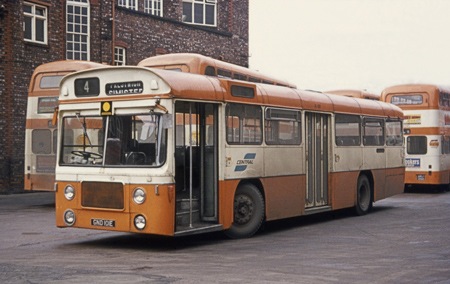
I took this photo of GND 101E in the yard at Frederick Road Depot at the time. I remember that whilst not as bad as the Panther Cubs – which had all gone by this time – these were still notoriously unreliable with a strong propensity towards catching fire.
John Stringer
17/10/12 – 08:10
David, Phil & John….Many Thanks for the tips and the information….I’d forgotten about the bridge at the other end of the route, but don’t remember if this was also just few hundred yards from the terminus.
I also received an e-mail from a friend a few minutes ago which adds on to Phil’s notes above – that the memory isn’t as bad as I feared and that the MCTD Leylands did, indeed, have a rear entrance….Strange for an underfloor engined single decker, no ??
And as I don’t know too much about copyright law, I won’t post here a picture of the famous NWRCC Atkinsons (yes, it wasn’t Albions) that he has sent to me, but here’s a link www.sct61.org.uk. They say that beauty is in the eye of the beholder, so I suppose ugliness is as well, and I can only say that my own eyes have these Atkinsons right up there as candidates….Thanks again.
Stuart C
17/10/12 – 08:15
Stuart, there’s a photo of a Manchester Royal Tiger on the 22 here: www.flickr.com
Peter Williamson
17/10/12 – 17:46
Rear entrance underfloor engined singles weren’t uncommon. Don’t forget OMO was still years away when these vehicles were ordered and the problems of driver distraction, union doubts about the driver controlling passenger access and egress existed in many urban areas where frequent stops were common. Also there was the problem of siting of stops relative to junctions where a rear entrance single worked fine and a front entrance would have caused an obstruction.
In London LT had plenty of red bus RFs but the Police wouldn’t allow them to have doors for years as it placed a burden on the driver and the door design at the time was deemed to limit visibility.
In the cases of MCTD and NWRCC, there was also a case of tradition and a slight reluctance to embrace a relatively untried idea.
Phil Blinkhorn
25/10/12 – 15:59
Re MCTD single deckers in the ’50’s. I seem to remember that the 97 to Platt Lane also was operated by Leyland single deckers for many years ….. presumably out of Princes Rd.
As for those Aberdonians, the damn things wound up on the rush hour express 130 from East Didsbury to Piccadilly once the Crossley’s had been withdrawn.
Orla Nutting
26/10/12 – 06:56
Orla, I seem to remember they used to leak as well as rattling a great deal
Phil Blinkhorn
16/12/12 – 07:25
Three, or possibly four, of the Aberdonians were transferred to Queens Road shortly before the end of their (Manchester) lives in order to work the 56 service which had been re-converted back to single-deck operation after a lengthy period of double-deck (PD1) service.
I liked them and remember them with affection and nostalgia and if they rattled they were by no means unique in the Manchester fleet on that account.
I always thought that they seemed far more at home on the 56 than in the exclusive, rarefied territory of Bramhall on the 31.
Johnny MacBrown
17/12/12 – 07:54
Manchester’s Aberdonians suffered from substandard bodywork (necessitated by time constraints following the Transport Committee’s rejection of the bid for Tiger Cubs), but I’ve always had a soft spot for the Aberdonian as a chassis. It was mechanically similar to the Tiger Cub but both quieter and livelier (the latter due to lower weight). Its main problem was that it was marketed, and often purchased, as a cheaper alternative to the Tiger Cub, but was nowhere near as rugged. It certainly wasn’t up to intensive city operation, but I’m pleased to hear that some of Manchester’s finally found a niche. I would imagine them to be in their element pottering around Higher Blackley on the 56.
Peter Williamson
24/05/15 – 07:37
Regarding rear entrance underfloor buses. The standard North Western joke was that if someone fell off the step of a rear entrance bus, the following vehicle ran them over, not the rear wheels of your own bus!
Bob Bracegirdle
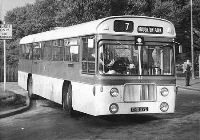 Vehicle reminder shot for this posting
Vehicle reminder shot for this posting
12/05/20 – 06:43
At the time these Panthers were delivered the PSV Circle used to hold monthly meetings at the Britons Protection Hotel at Lower Moseley Street – does anyone else remember them? One evening they hired a new Panther for a run around the City, can’t recall anything about it-on another occasion they hired a new Bedford VAM for a similar trip but I don’t know the operator.
They were good meetings, the late John Cockshott was always there, I usually bought a photo or two from him all of which I still have.
Ian Wild
